Coolco Case Study: Strategic HRM, STEEPLE Analysis & Stakeholder
VerifiedAdded on 2023/06/17
|11
|3168
|498
Report
AI Summary
This report provides an analysis of the strategic human resource management (HRM) context within Coolco, a UK-based food business established in 1978. It begins with a STEEPLE analysis to identify external factors impacting the company, including social, technological, economic, environmental, political, legal, and ethical considerations. The report then identifies and analyzes three socio-cultural (culture, customer preference, language) and three socio-economic factors (gender equality, competitors, globalization) influencing HRM interventions such as performance management, workforce diversity, and talent development. A critical evaluation of stakeholder interests follows, highlighting the importance of managing stakeholders based on their power and interest. The report concludes with recommendations for Coolco to effectively navigate these strategic HRM challenges and opportunities. Desklib provides this and many other solved assignments to help students.
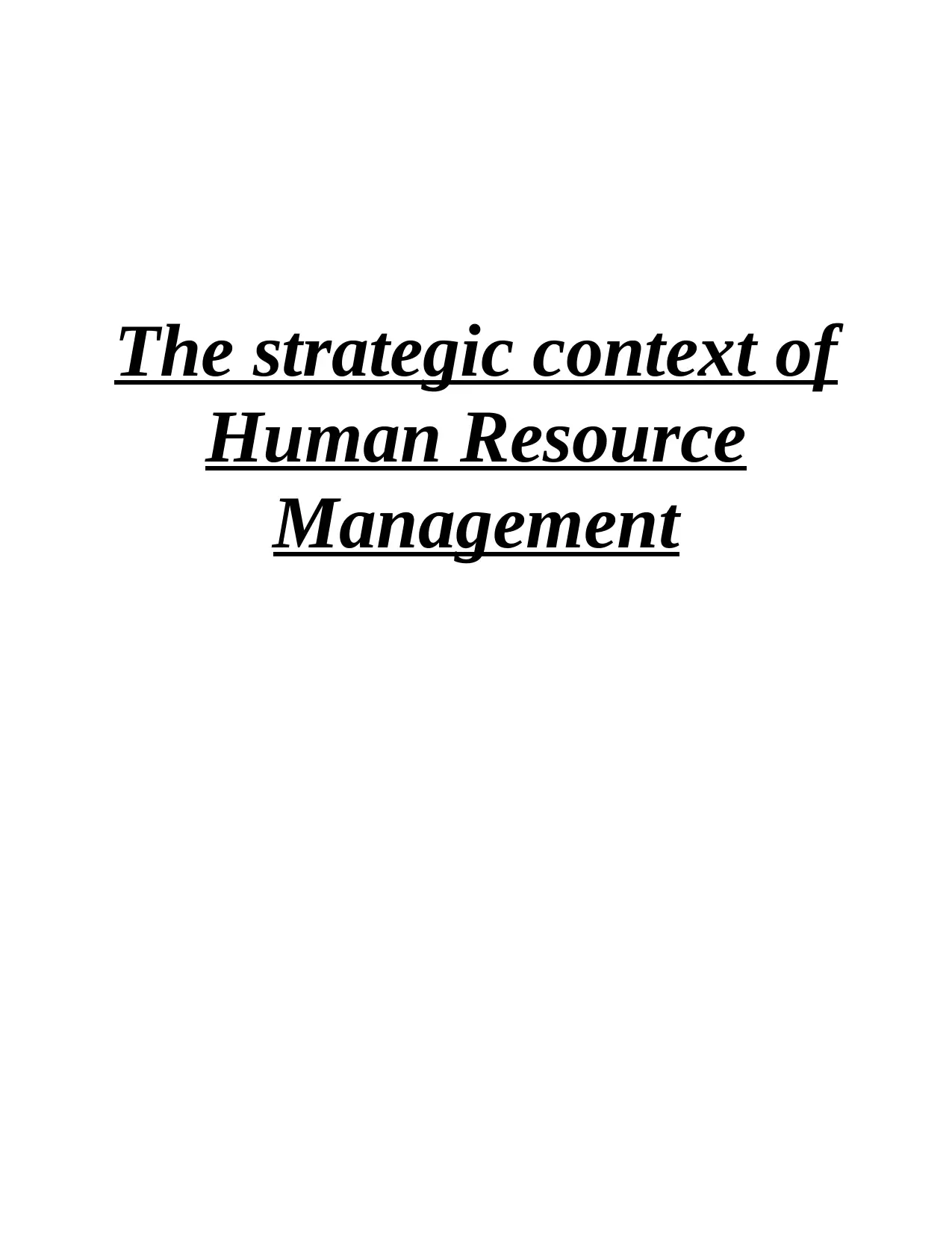
The strategic context of
Human Resource
Management
Human Resource
Management
Paraphrase This Document
Need a fresh take? Get an instant paraphrase of this document with our AI Paraphraser
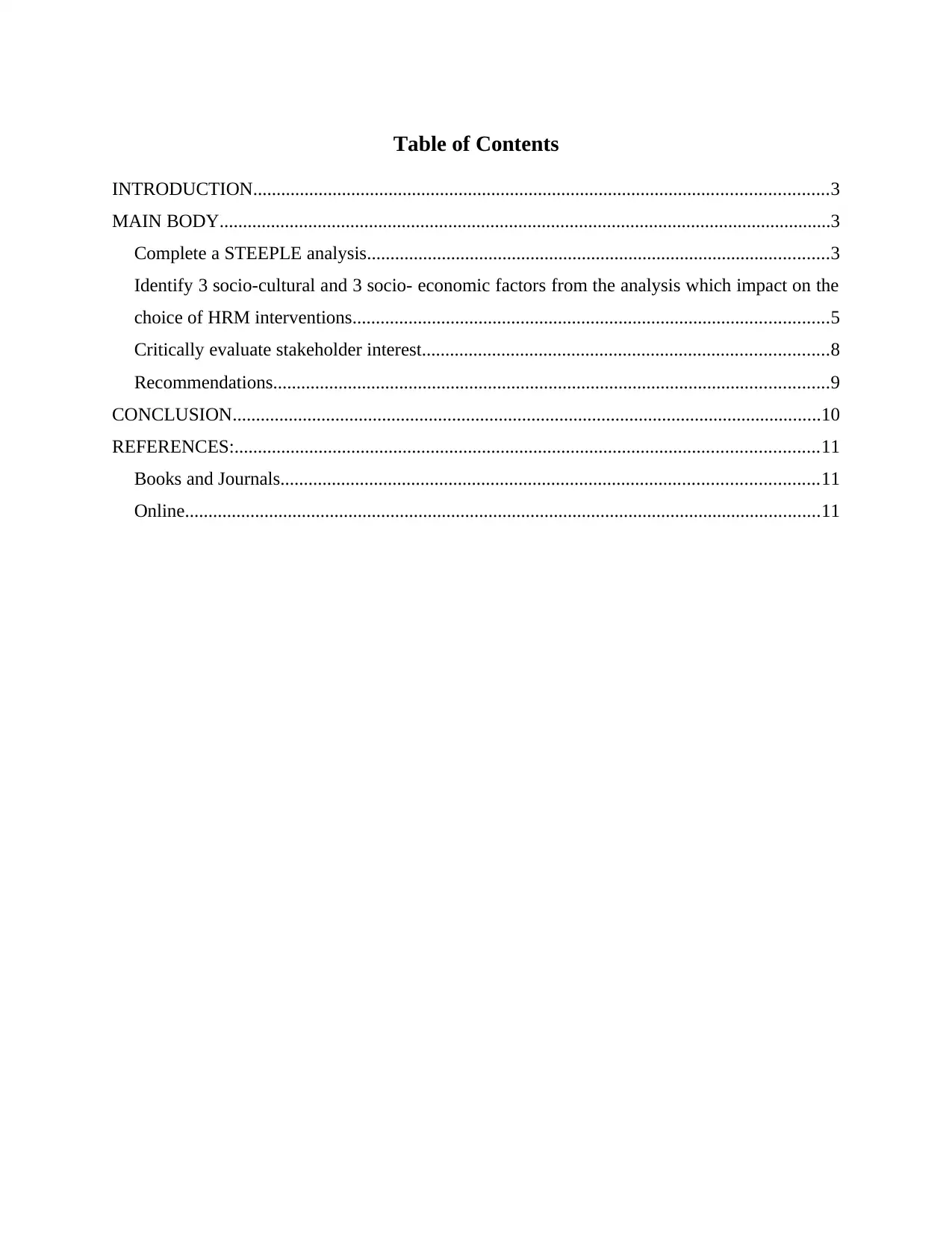
Table of Contents
INTRODUCTION...........................................................................................................................3
MAIN BODY...................................................................................................................................3
Complete a STEEPLE analysis...................................................................................................3
Identify 3 socio-cultural and 3 socio- economic factors from the analysis which impact on the
choice of HRM interventions......................................................................................................5
Critically evaluate stakeholder interest.......................................................................................8
Recommendations.......................................................................................................................9
CONCLUSION..............................................................................................................................10
REFERENCES:.............................................................................................................................11
Books and Journals...................................................................................................................11
Online........................................................................................................................................11
INTRODUCTION...........................................................................................................................3
MAIN BODY...................................................................................................................................3
Complete a STEEPLE analysis...................................................................................................3
Identify 3 socio-cultural and 3 socio- economic factors from the analysis which impact on the
choice of HRM interventions......................................................................................................5
Critically evaluate stakeholder interest.......................................................................................8
Recommendations.......................................................................................................................9
CONCLUSION..............................................................................................................................10
REFERENCES:.............................................................................................................................11
Books and Journals...................................................................................................................11
Online........................................................................................................................................11
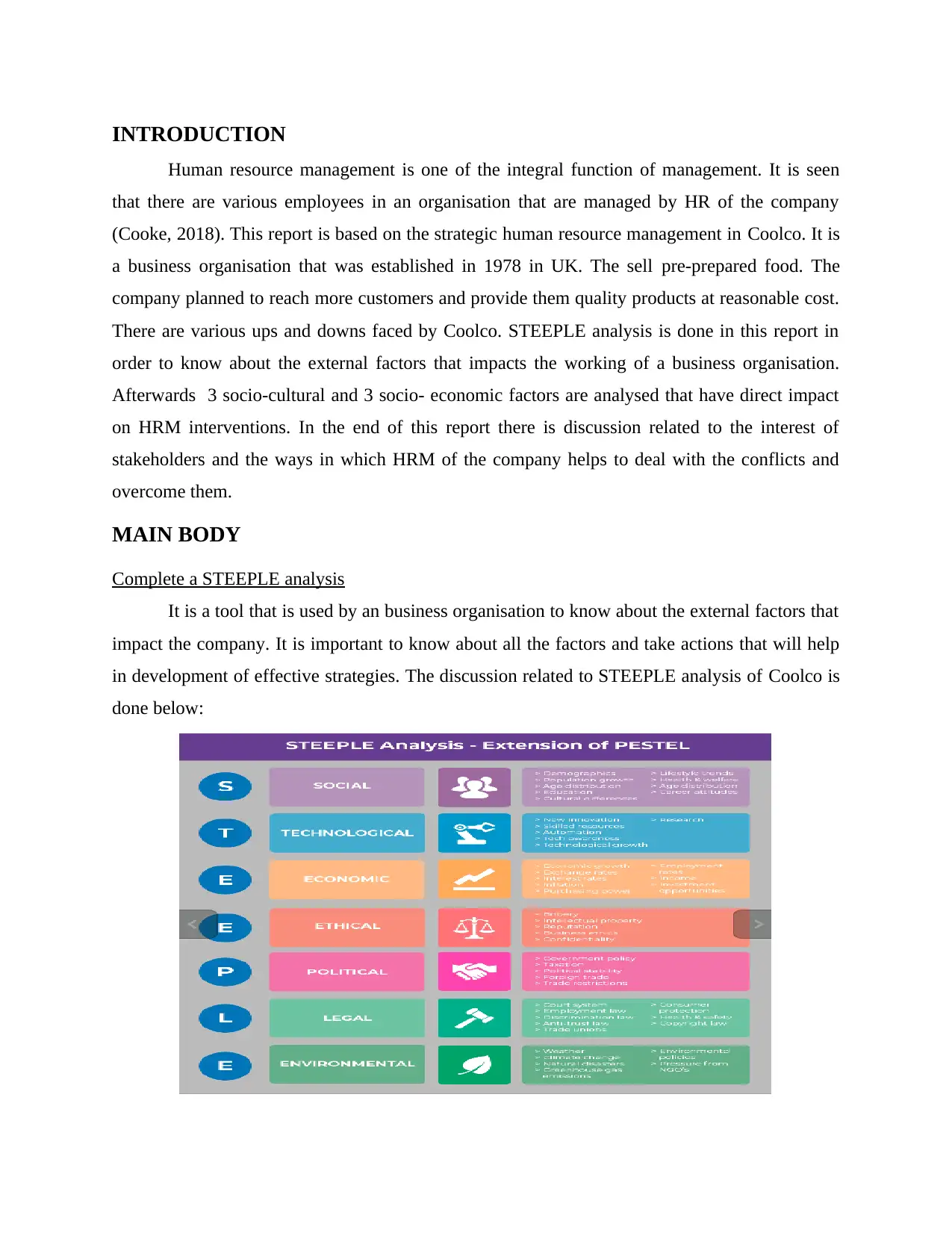
INTRODUCTION
Human resource management is one of the integral function of management. It is seen
that there are various employees in an organisation that are managed by HR of the company
(Cooke, 2018). This report is based on the strategic human resource management in Coolco. It is
a business organisation that was established in 1978 in UK. The sell pre-prepared food. The
company planned to reach more customers and provide them quality products at reasonable cost.
There are various ups and downs faced by Coolco. STEEPLE analysis is done in this report in
order to know about the external factors that impacts the working of a business organisation.
Afterwards 3 socio-cultural and 3 socio- economic factors are analysed that have direct impact
on HRM interventions. In the end of this report there is discussion related to the interest of
stakeholders and the ways in which HRM of the company helps to deal with the conflicts and
overcome them.
MAIN BODY
Complete a STEEPLE analysis
It is a tool that is used by an business organisation to know about the external factors that
impact the company. It is important to know about all the factors and take actions that will help
in development of effective strategies. The discussion related to STEEPLE analysis of Coolco is
done below:
Human resource management is one of the integral function of management. It is seen
that there are various employees in an organisation that are managed by HR of the company
(Cooke, 2018). This report is based on the strategic human resource management in Coolco. It is
a business organisation that was established in 1978 in UK. The sell pre-prepared food. The
company planned to reach more customers and provide them quality products at reasonable cost.
There are various ups and downs faced by Coolco. STEEPLE analysis is done in this report in
order to know about the external factors that impacts the working of a business organisation.
Afterwards 3 socio-cultural and 3 socio- economic factors are analysed that have direct impact
on HRM interventions. In the end of this report there is discussion related to the interest of
stakeholders and the ways in which HRM of the company helps to deal with the conflicts and
overcome them.
MAIN BODY
Complete a STEEPLE analysis
It is a tool that is used by an business organisation to know about the external factors that
impact the company. It is important to know about all the factors and take actions that will help
in development of effective strategies. The discussion related to STEEPLE analysis of Coolco is
done below:
⊘ This is a preview!⊘
Do you want full access?
Subscribe today to unlock all pages.

Trusted by 1+ million students worldwide
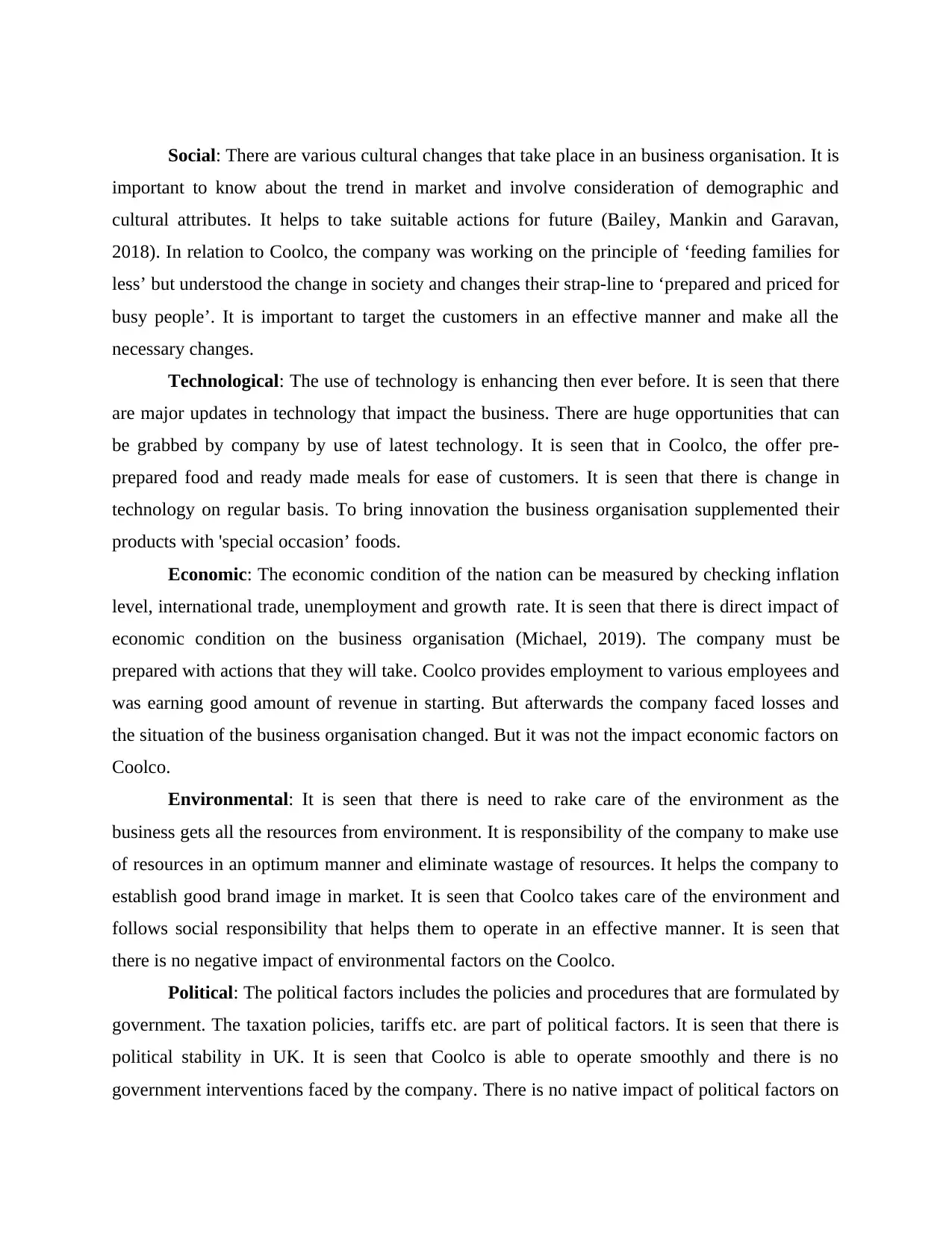
Social: There are various cultural changes that take place in an business organisation. It is
important to know about the trend in market and involve consideration of demographic and
cultural attributes. It helps to take suitable actions for future (Bailey, Mankin and Garavan,
2018). In relation to Coolco, the company was working on the principle of ‘feeding families for
less’ but understood the change in society and changes their strap-line to ‘prepared and priced for
busy people’. It is important to target the customers in an effective manner and make all the
necessary changes.
Technological: The use of technology is enhancing then ever before. It is seen that there
are major updates in technology that impact the business. There are huge opportunities that can
be grabbed by company by use of latest technology. It is seen that in Coolco, the offer pre-
prepared food and ready made meals for ease of customers. It is seen that there is change in
technology on regular basis. To bring innovation the business organisation supplemented their
products with 'special occasion’ foods.
Economic: The economic condition of the nation can be measured by checking inflation
level, international trade, unemployment and growth rate. It is seen that there is direct impact of
economic condition on the business organisation (Michael, 2019). The company must be
prepared with actions that they will take. Coolco provides employment to various employees and
was earning good amount of revenue in starting. But afterwards the company faced losses and
the situation of the business organisation changed. But it was not the impact economic factors on
Coolco.
Environmental: It is seen that there is need to rake care of the environment as the
business gets all the resources from environment. It is responsibility of the company to make use
of resources in an optimum manner and eliminate wastage of resources. It helps the company to
establish good brand image in market. It is seen that Coolco takes care of the environment and
follows social responsibility that helps them to operate in an effective manner. It is seen that
there is no negative impact of environmental factors on the Coolco.
Political: The political factors includes the policies and procedures that are formulated by
government. The taxation policies, tariffs etc. are part of political factors. It is seen that there is
political stability in UK. It is seen that Coolco is able to operate smoothly and there is no
government interventions faced by the company. There is no native impact of political factors on
important to know about the trend in market and involve consideration of demographic and
cultural attributes. It helps to take suitable actions for future (Bailey, Mankin and Garavan,
2018). In relation to Coolco, the company was working on the principle of ‘feeding families for
less’ but understood the change in society and changes their strap-line to ‘prepared and priced for
busy people’. It is important to target the customers in an effective manner and make all the
necessary changes.
Technological: The use of technology is enhancing then ever before. It is seen that there
are major updates in technology that impact the business. There are huge opportunities that can
be grabbed by company by use of latest technology. It is seen that in Coolco, the offer pre-
prepared food and ready made meals for ease of customers. It is seen that there is change in
technology on regular basis. To bring innovation the business organisation supplemented their
products with 'special occasion’ foods.
Economic: The economic condition of the nation can be measured by checking inflation
level, international trade, unemployment and growth rate. It is seen that there is direct impact of
economic condition on the business organisation (Michael, 2019). The company must be
prepared with actions that they will take. Coolco provides employment to various employees and
was earning good amount of revenue in starting. But afterwards the company faced losses and
the situation of the business organisation changed. But it was not the impact economic factors on
Coolco.
Environmental: It is seen that there is need to rake care of the environment as the
business gets all the resources from environment. It is responsibility of the company to make use
of resources in an optimum manner and eliminate wastage of resources. It helps the company to
establish good brand image in market. It is seen that Coolco takes care of the environment and
follows social responsibility that helps them to operate in an effective manner. It is seen that
there is no negative impact of environmental factors on the Coolco.
Political: The political factors includes the policies and procedures that are formulated by
government. The taxation policies, tariffs etc. are part of political factors. It is seen that there is
political stability in UK. It is seen that Coolco is able to operate smoothly and there is no
government interventions faced by the company. There is no native impact of political factors on
Paraphrase This Document
Need a fresh take? Get an instant paraphrase of this document with our AI Paraphraser
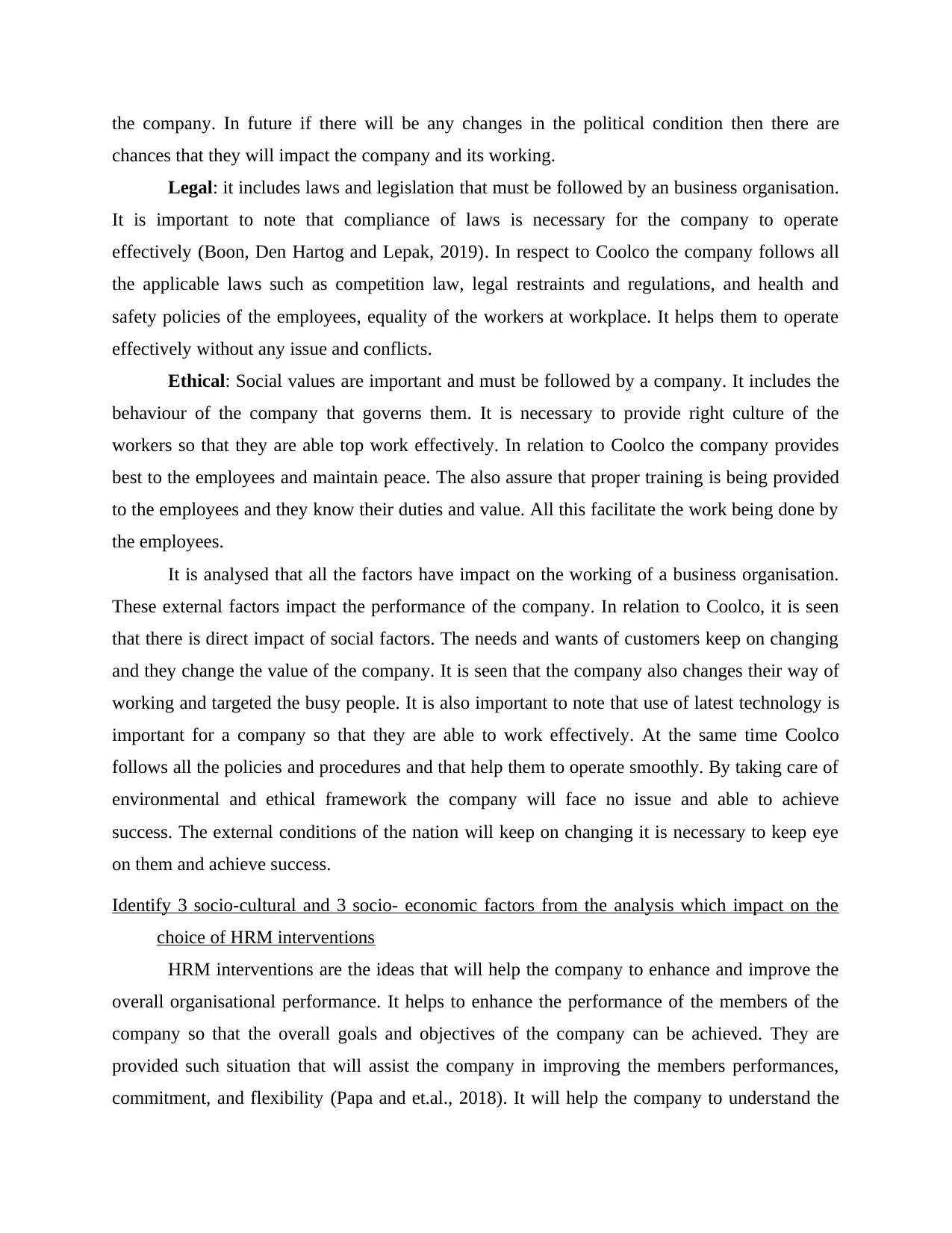
the company. In future if there will be any changes in the political condition then there are
chances that they will impact the company and its working.
Legal: it includes laws and legislation that must be followed by an business organisation.
It is important to note that compliance of laws is necessary for the company to operate
effectively (Boon, Den Hartog and Lepak, 2019). In respect to Coolco the company follows all
the applicable laws such as competition law, legal restraints and regulations, and health and
safety policies of the employees, equality of the workers at workplace. It helps them to operate
effectively without any issue and conflicts.
Ethical: Social values are important and must be followed by a company. It includes the
behaviour of the company that governs them. It is necessary to provide right culture of the
workers so that they are able top work effectively. In relation to Coolco the company provides
best to the employees and maintain peace. The also assure that proper training is being provided
to the employees and they know their duties and value. All this facilitate the work being done by
the employees.
It is analysed that all the factors have impact on the working of a business organisation.
These external factors impact the performance of the company. In relation to Coolco, it is seen
that there is direct impact of social factors. The needs and wants of customers keep on changing
and they change the value of the company. It is seen that the company also changes their way of
working and targeted the busy people. It is also important to note that use of latest technology is
important for a company so that they are able to work effectively. At the same time Coolco
follows all the policies and procedures and that help them to operate smoothly. By taking care of
environmental and ethical framework the company will face no issue and able to achieve
success. The external conditions of the nation will keep on changing it is necessary to keep eye
on them and achieve success.
Identify 3 socio-cultural and 3 socio- economic factors from the analysis which impact on the
choice of HRM interventions
HRM interventions are the ideas that will help the company to enhance and improve the
overall organisational performance. It helps to enhance the performance of the members of the
company so that the overall goals and objectives of the company can be achieved. They are
provided such situation that will assist the company in improving the members performances,
commitment, and flexibility (Papa and et.al., 2018). It will help the company to understand the
chances that they will impact the company and its working.
Legal: it includes laws and legislation that must be followed by an business organisation.
It is important to note that compliance of laws is necessary for the company to operate
effectively (Boon, Den Hartog and Lepak, 2019). In respect to Coolco the company follows all
the applicable laws such as competition law, legal restraints and regulations, and health and
safety policies of the employees, equality of the workers at workplace. It helps them to operate
effectively without any issue and conflicts.
Ethical: Social values are important and must be followed by a company. It includes the
behaviour of the company that governs them. It is necessary to provide right culture of the
workers so that they are able top work effectively. In relation to Coolco the company provides
best to the employees and maintain peace. The also assure that proper training is being provided
to the employees and they know their duties and value. All this facilitate the work being done by
the employees.
It is analysed that all the factors have impact on the working of a business organisation.
These external factors impact the performance of the company. In relation to Coolco, it is seen
that there is direct impact of social factors. The needs and wants of customers keep on changing
and they change the value of the company. It is seen that the company also changes their way of
working and targeted the busy people. It is also important to note that use of latest technology is
important for a company so that they are able to work effectively. At the same time Coolco
follows all the policies and procedures and that help them to operate smoothly. By taking care of
environmental and ethical framework the company will face no issue and able to achieve
success. The external conditions of the nation will keep on changing it is necessary to keep eye
on them and achieve success.
Identify 3 socio-cultural and 3 socio- economic factors from the analysis which impact on the
choice of HRM interventions
HRM interventions are the ideas that will help the company to enhance and improve the
overall organisational performance. It helps to enhance the performance of the members of the
company so that the overall goals and objectives of the company can be achieved. They are
provided such situation that will assist the company in improving the members performances,
commitment, and flexibility (Papa and et.al., 2018). It will help the company to understand the
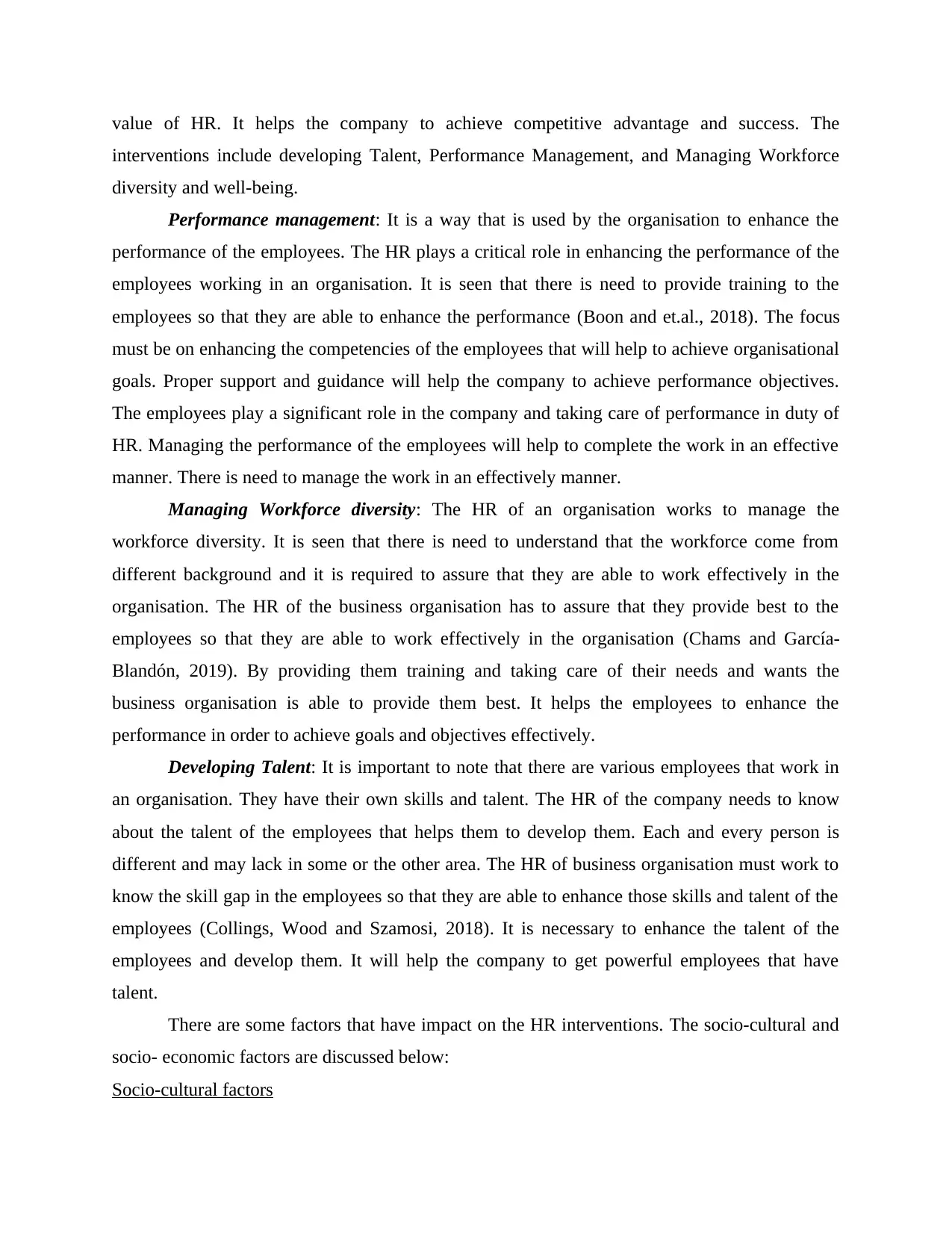
value of HR. It helps the company to achieve competitive advantage and success. The
interventions include developing Talent, Performance Management, and Managing Workforce
diversity and well-being.
Performance management: It is a way that is used by the organisation to enhance the
performance of the employees. The HR plays a critical role in enhancing the performance of the
employees working in an organisation. It is seen that there is need to provide training to the
employees so that they are able to enhance the performance (Boon and et.al., 2018). The focus
must be on enhancing the competencies of the employees that will help to achieve organisational
goals. Proper support and guidance will help the company to achieve performance objectives.
The employees play a significant role in the company and taking care of performance in duty of
HR. Managing the performance of the employees will help to complete the work in an effective
manner. There is need to manage the work in an effectively manner.
Managing Workforce diversity: The HR of an organisation works to manage the
workforce diversity. It is seen that there is need to understand that the workforce come from
different background and it is required to assure that they are able to work effectively in the
organisation. The HR of the business organisation has to assure that they provide best to the
employees so that they are able to work effectively in the organisation (Chams and García-
Blandón, 2019). By providing them training and taking care of their needs and wants the
business organisation is able to provide them best. It helps the employees to enhance the
performance in order to achieve goals and objectives effectively.
Developing Talent: It is important to note that there are various employees that work in
an organisation. They have their own skills and talent. The HR of the company needs to know
about the talent of the employees that helps them to develop them. Each and every person is
different and may lack in some or the other area. The HR of business organisation must work to
know the skill gap in the employees so that they are able to enhance those skills and talent of the
employees (Collings, Wood and Szamosi, 2018). It is necessary to enhance the talent of the
employees and develop them. It will help the company to get powerful employees that have
talent.
There are some factors that have impact on the HR interventions. The socio-cultural and
socio- economic factors are discussed below:
Socio-cultural factors
interventions include developing Talent, Performance Management, and Managing Workforce
diversity and well-being.
Performance management: It is a way that is used by the organisation to enhance the
performance of the employees. The HR plays a critical role in enhancing the performance of the
employees working in an organisation. It is seen that there is need to provide training to the
employees so that they are able to enhance the performance (Boon and et.al., 2018). The focus
must be on enhancing the competencies of the employees that will help to achieve organisational
goals. Proper support and guidance will help the company to achieve performance objectives.
The employees play a significant role in the company and taking care of performance in duty of
HR. Managing the performance of the employees will help to complete the work in an effective
manner. There is need to manage the work in an effectively manner.
Managing Workforce diversity: The HR of an organisation works to manage the
workforce diversity. It is seen that there is need to understand that the workforce come from
different background and it is required to assure that they are able to work effectively in the
organisation. The HR of the business organisation has to assure that they provide best to the
employees so that they are able to work effectively in the organisation (Chams and García-
Blandón, 2019). By providing them training and taking care of their needs and wants the
business organisation is able to provide them best. It helps the employees to enhance the
performance in order to achieve goals and objectives effectively.
Developing Talent: It is important to note that there are various employees that work in
an organisation. They have their own skills and talent. The HR of the company needs to know
about the talent of the employees that helps them to develop them. Each and every person is
different and may lack in some or the other area. The HR of business organisation must work to
know the skill gap in the employees so that they are able to enhance those skills and talent of the
employees (Collings, Wood and Szamosi, 2018). It is necessary to enhance the talent of the
employees and develop them. It will help the company to get powerful employees that have
talent.
There are some factors that have impact on the HR interventions. The socio-cultural and
socio- economic factors are discussed below:
Socio-cultural factors
⊘ This is a preview!⊘
Do you want full access?
Subscribe today to unlock all pages.

Trusted by 1+ million students worldwide
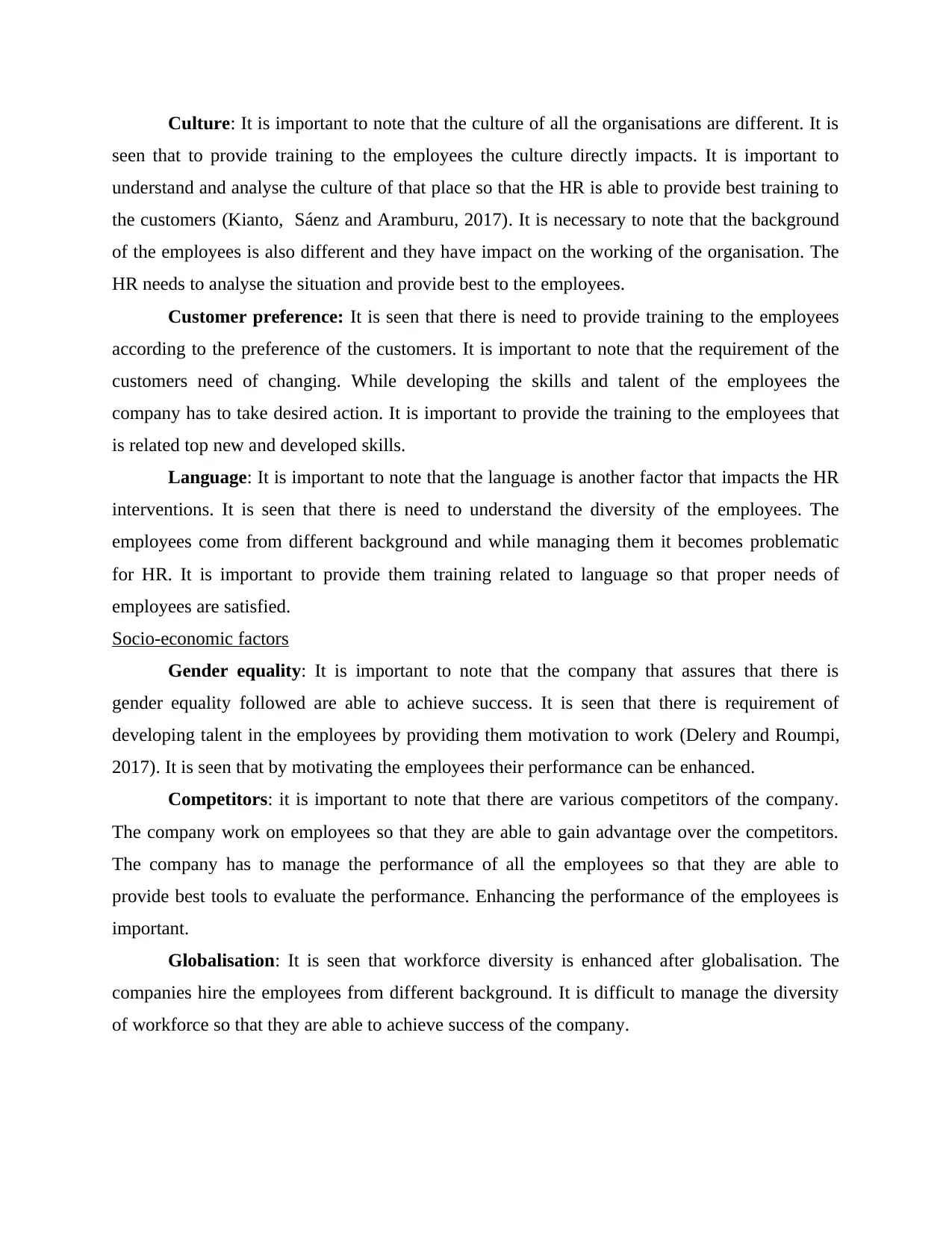
Culture: It is important to note that the culture of all the organisations are different. It is
seen that to provide training to the employees the culture directly impacts. It is important to
understand and analyse the culture of that place so that the HR is able to provide best training to
the customers (Kianto, Sáenz and Aramburu, 2017). It is necessary to note that the background
of the employees is also different and they have impact on the working of the organisation. The
HR needs to analyse the situation and provide best to the employees.
Customer preference: It is seen that there is need to provide training to the employees
according to the preference of the customers. It is important to note that the requirement of the
customers need of changing. While developing the skills and talent of the employees the
company has to take desired action. It is important to provide the training to the employees that
is related top new and developed skills.
Language: It is important to note that the language is another factor that impacts the HR
interventions. It is seen that there is need to understand the diversity of the employees. The
employees come from different background and while managing them it becomes problematic
for HR. It is important to provide them training related to language so that proper needs of
employees are satisfied.
Socio-economic factors
Gender equality: It is important to note that the company that assures that there is
gender equality followed are able to achieve success. It is seen that there is requirement of
developing talent in the employees by providing them motivation to work (Delery and Roumpi,
2017). It is seen that by motivating the employees their performance can be enhanced.
Competitors: it is important to note that there are various competitors of the company.
The company work on employees so that they are able to gain advantage over the competitors.
The company has to manage the performance of all the employees so that they are able to
provide best tools to evaluate the performance. Enhancing the performance of the employees is
important.
Globalisation: It is seen that workforce diversity is enhanced after globalisation. The
companies hire the employees from different background. It is difficult to manage the diversity
of workforce so that they are able to achieve success of the company.
seen that to provide training to the employees the culture directly impacts. It is important to
understand and analyse the culture of that place so that the HR is able to provide best training to
the customers (Kianto, Sáenz and Aramburu, 2017). It is necessary to note that the background
of the employees is also different and they have impact on the working of the organisation. The
HR needs to analyse the situation and provide best to the employees.
Customer preference: It is seen that there is need to provide training to the employees
according to the preference of the customers. It is important to note that the requirement of the
customers need of changing. While developing the skills and talent of the employees the
company has to take desired action. It is important to provide the training to the employees that
is related top new and developed skills.
Language: It is important to note that the language is another factor that impacts the HR
interventions. It is seen that there is need to understand the diversity of the employees. The
employees come from different background and while managing them it becomes problematic
for HR. It is important to provide them training related to language so that proper needs of
employees are satisfied.
Socio-economic factors
Gender equality: It is important to note that the company that assures that there is
gender equality followed are able to achieve success. It is seen that there is requirement of
developing talent in the employees by providing them motivation to work (Delery and Roumpi,
2017). It is seen that by motivating the employees their performance can be enhanced.
Competitors: it is important to note that there are various competitors of the company.
The company work on employees so that they are able to gain advantage over the competitors.
The company has to manage the performance of all the employees so that they are able to
provide best tools to evaluate the performance. Enhancing the performance of the employees is
important.
Globalisation: It is seen that workforce diversity is enhanced after globalisation. The
companies hire the employees from different background. It is difficult to manage the diversity
of workforce so that they are able to achieve success of the company.
Paraphrase This Document
Need a fresh take? Get an instant paraphrase of this document with our AI Paraphraser
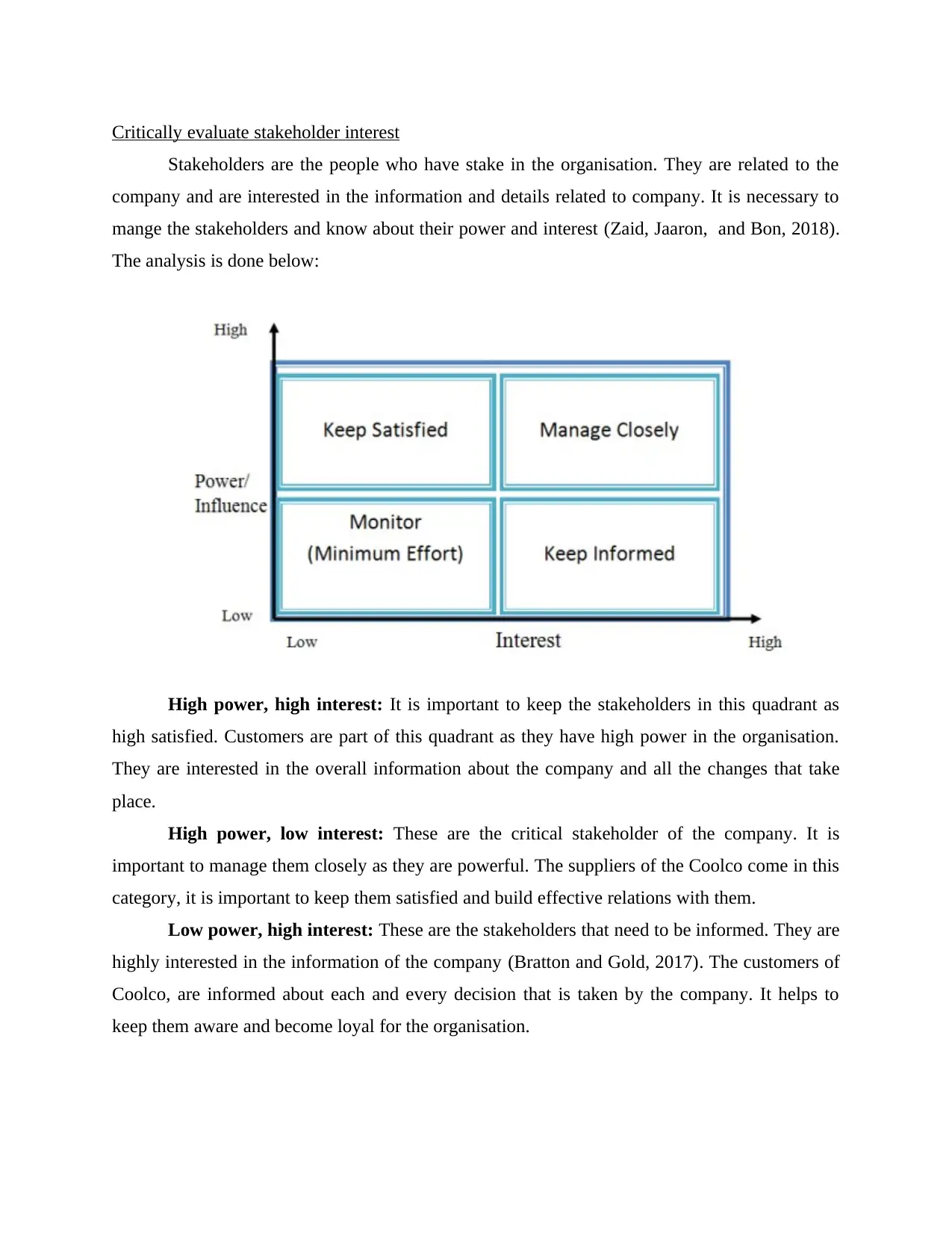
Critically evaluate stakeholder interest
Stakeholders are the people who have stake in the organisation. They are related to the
company and are interested in the information and details related to company. It is necessary to
mange the stakeholders and know about their power and interest (Zaid, Jaaron, and Bon, 2018).
The analysis is done below:
High power, high interest: It is important to keep the stakeholders in this quadrant as
high satisfied. Customers are part of this quadrant as they have high power in the organisation.
They are interested in the overall information about the company and all the changes that take
place.
High power, low interest: These are the critical stakeholder of the company. It is
important to manage them closely as they are powerful. The suppliers of the Coolco come in this
category, it is important to keep them satisfied and build effective relations with them.
Low power, high interest: These are the stakeholders that need to be informed. They are
highly interested in the information of the company (Bratton and Gold, 2017). The customers of
Coolco, are informed about each and every decision that is taken by the company. It helps to
keep them aware and become loyal for the organisation.
Stakeholders are the people who have stake in the organisation. They are related to the
company and are interested in the information and details related to company. It is necessary to
mange the stakeholders and know about their power and interest (Zaid, Jaaron, and Bon, 2018).
The analysis is done below:
High power, high interest: It is important to keep the stakeholders in this quadrant as
high satisfied. Customers are part of this quadrant as they have high power in the organisation.
They are interested in the overall information about the company and all the changes that take
place.
High power, low interest: These are the critical stakeholder of the company. It is
important to manage them closely as they are powerful. The suppliers of the Coolco come in this
category, it is important to keep them satisfied and build effective relations with them.
Low power, high interest: These are the stakeholders that need to be informed. They are
highly interested in the information of the company (Bratton and Gold, 2017). The customers of
Coolco, are informed about each and every decision that is taken by the company. It helps to
keep them aware and become loyal for the organisation.
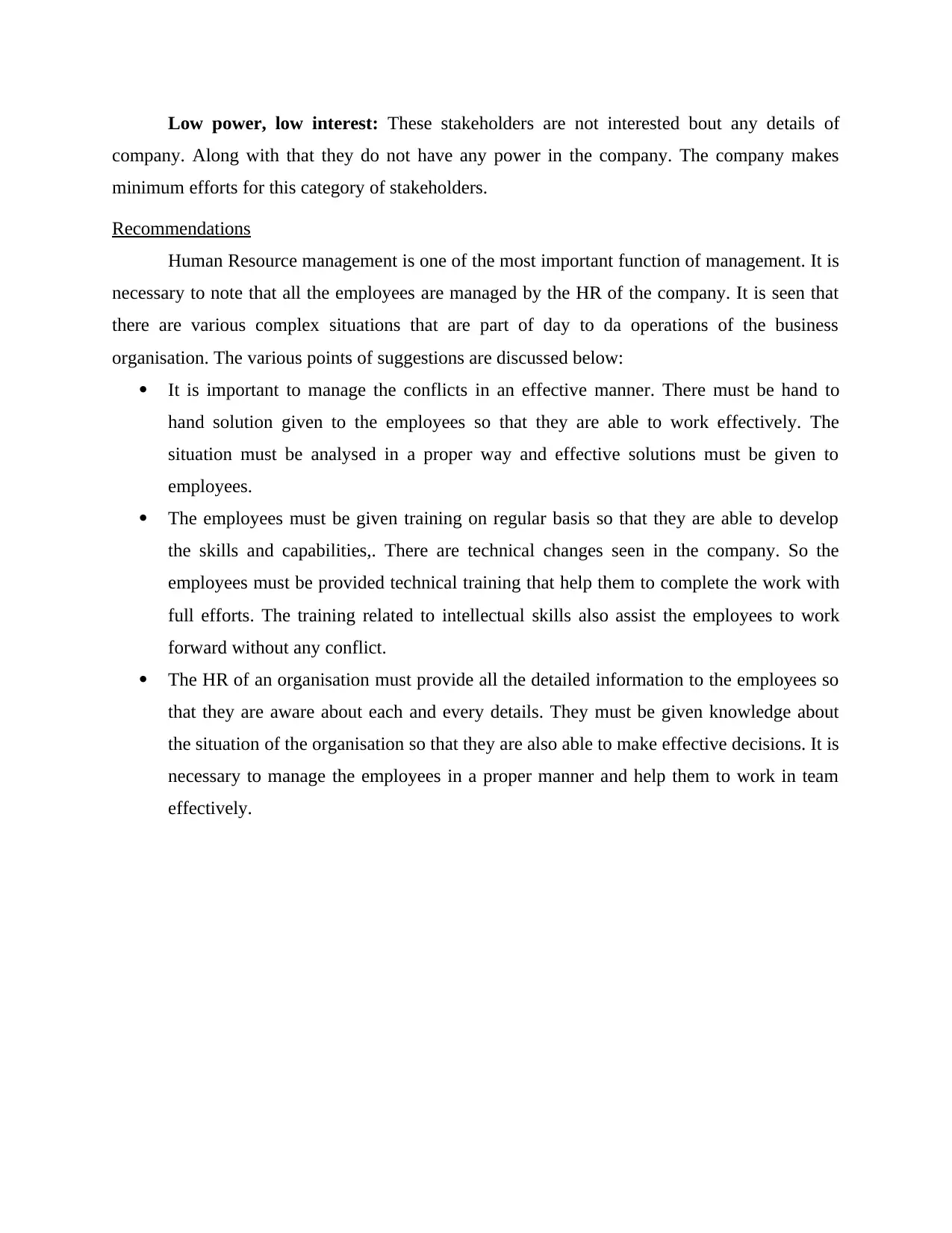
Low power, low interest: These stakeholders are not interested bout any details of
company. Along with that they do not have any power in the company. The company makes
minimum efforts for this category of stakeholders.
Recommendations
Human Resource management is one of the most important function of management. It is
necessary to note that all the employees are managed by the HR of the company. It is seen that
there are various complex situations that are part of day to da operations of the business
organisation. The various points of suggestions are discussed below:
It is important to manage the conflicts in an effective manner. There must be hand to
hand solution given to the employees so that they are able to work effectively. The
situation must be analysed in a proper way and effective solutions must be given to
employees.
The employees must be given training on regular basis so that they are able to develop
the skills and capabilities,. There are technical changes seen in the company. So the
employees must be provided technical training that help them to complete the work with
full efforts. The training related to intellectual skills also assist the employees to work
forward without any conflict.
The HR of an organisation must provide all the detailed information to the employees so
that they are aware about each and every details. They must be given knowledge about
the situation of the organisation so that they are also able to make effective decisions. It is
necessary to manage the employees in a proper manner and help them to work in team
effectively.
company. Along with that they do not have any power in the company. The company makes
minimum efforts for this category of stakeholders.
Recommendations
Human Resource management is one of the most important function of management. It is
necessary to note that all the employees are managed by the HR of the company. It is seen that
there are various complex situations that are part of day to da operations of the business
organisation. The various points of suggestions are discussed below:
It is important to manage the conflicts in an effective manner. There must be hand to
hand solution given to the employees so that they are able to work effectively. The
situation must be analysed in a proper way and effective solutions must be given to
employees.
The employees must be given training on regular basis so that they are able to develop
the skills and capabilities,. There are technical changes seen in the company. So the
employees must be provided technical training that help them to complete the work with
full efforts. The training related to intellectual skills also assist the employees to work
forward without any conflict.
The HR of an organisation must provide all the detailed information to the employees so
that they are aware about each and every details. They must be given knowledge about
the situation of the organisation so that they are also able to make effective decisions. It is
necessary to manage the employees in a proper manner and help them to work in team
effectively.
⊘ This is a preview!⊘
Do you want full access?
Subscribe today to unlock all pages.

Trusted by 1+ million students worldwide
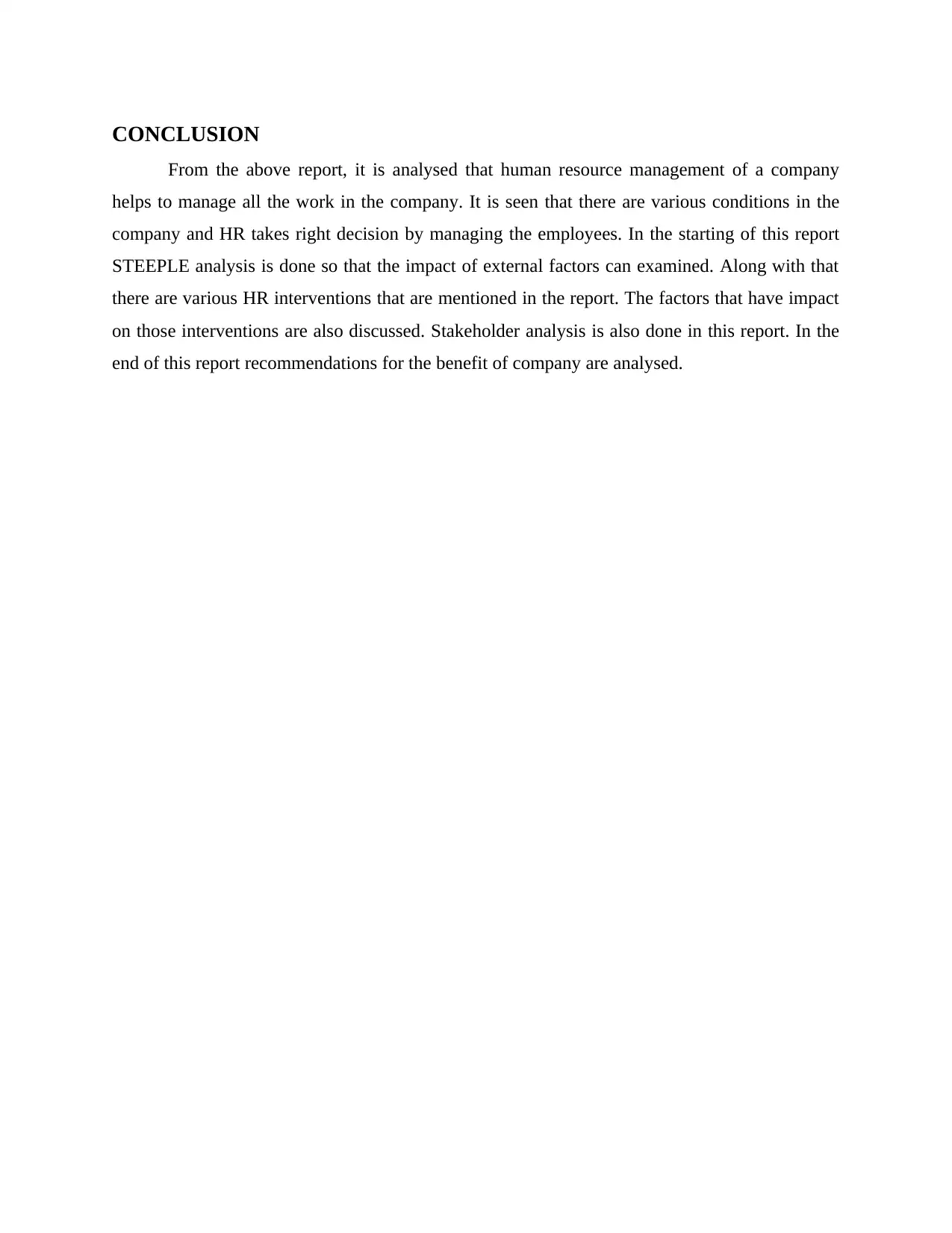
CONCLUSION
From the above report, it is analysed that human resource management of a company
helps to manage all the work in the company. It is seen that there are various conditions in the
company and HR takes right decision by managing the employees. In the starting of this report
STEEPLE analysis is done so that the impact of external factors can examined. Along with that
there are various HR interventions that are mentioned in the report. The factors that have impact
on those interventions are also discussed. Stakeholder analysis is also done in this report. In the
end of this report recommendations for the benefit of company are analysed.
From the above report, it is analysed that human resource management of a company
helps to manage all the work in the company. It is seen that there are various conditions in the
company and HR takes right decision by managing the employees. In the starting of this report
STEEPLE analysis is done so that the impact of external factors can examined. Along with that
there are various HR interventions that are mentioned in the report. The factors that have impact
on those interventions are also discussed. Stakeholder analysis is also done in this report. In the
end of this report recommendations for the benefit of company are analysed.
Paraphrase This Document
Need a fresh take? Get an instant paraphrase of this document with our AI Paraphraser
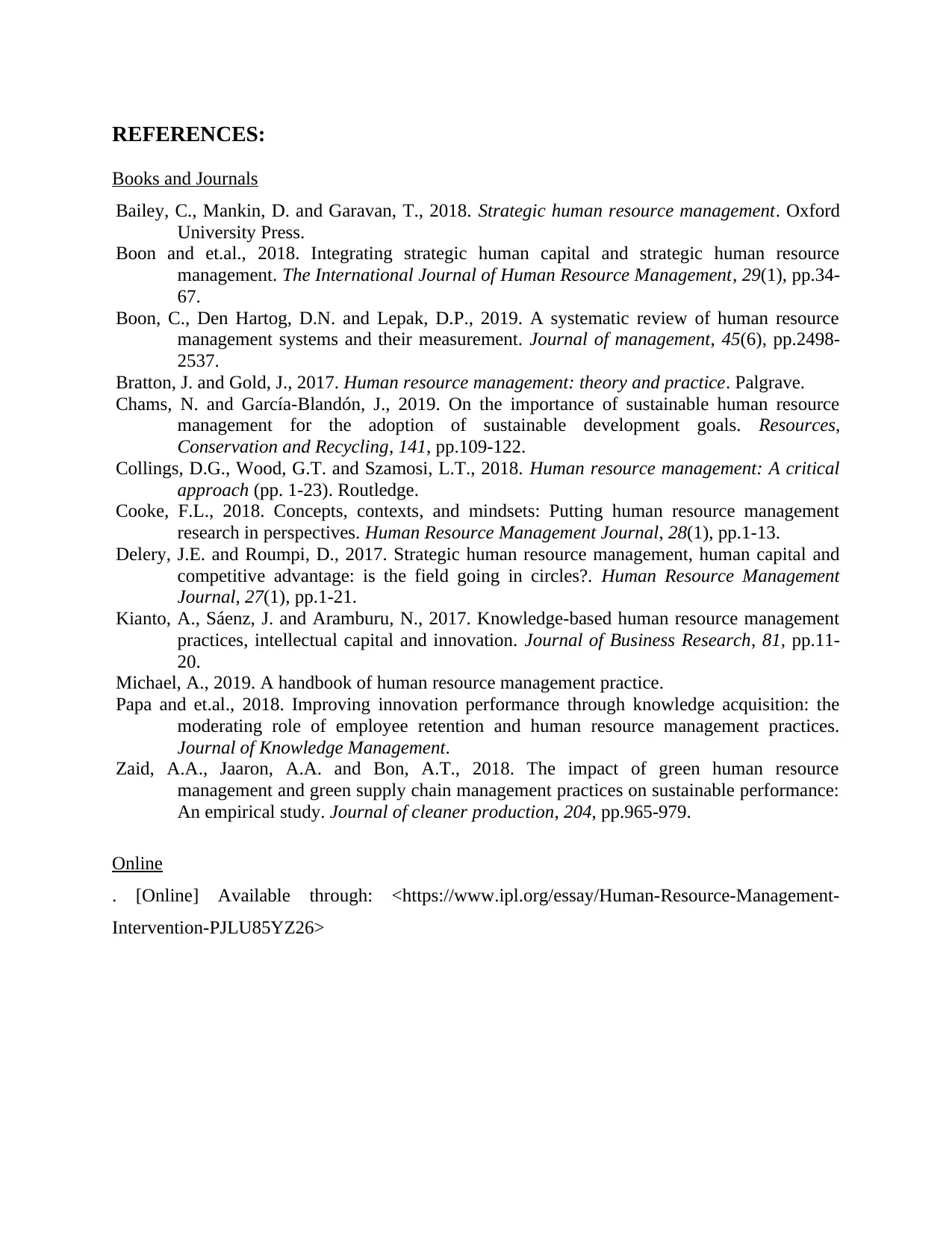
REFERENCES:
Books and Journals
Bailey, C., Mankin, D. and Garavan, T., 2018. Strategic human resource management. Oxford
University Press.
Boon and et.al., 2018. Integrating strategic human capital and strategic human resource
management. The International Journal of Human Resource Management, 29(1), pp.34-
67.
Boon, C., Den Hartog, D.N. and Lepak, D.P., 2019. A systematic review of human resource
management systems and their measurement. Journal of management, 45(6), pp.2498-
2537.
Bratton, J. and Gold, J., 2017. Human resource management: theory and practice. Palgrave.
Chams, N. and García-Blandón, J., 2019. On the importance of sustainable human resource
management for the adoption of sustainable development goals. Resources,
Conservation and Recycling, 141, pp.109-122.
Collings, D.G., Wood, G.T. and Szamosi, L.T., 2018. Human resource management: A critical
approach (pp. 1-23). Routledge.
Cooke, F.L., 2018. Concepts, contexts, and mindsets: Putting human resource management
research in perspectives. Human Resource Management Journal, 28(1), pp.1-13.
Delery, J.E. and Roumpi, D., 2017. Strategic human resource management, human capital and
competitive advantage: is the field going in circles?. Human Resource Management
Journal, 27(1), pp.1-21.
Kianto, A., Sáenz, J. and Aramburu, N., 2017. Knowledge-based human resource management
practices, intellectual capital and innovation. Journal of Business Research, 81, pp.11-
20.
Michael, A., 2019. A handbook of human resource management practice.
Papa and et.al., 2018. Improving innovation performance through knowledge acquisition: the
moderating role of employee retention and human resource management practices.
Journal of Knowledge Management.
Zaid, A.A., Jaaron, A.A. and Bon, A.T., 2018. The impact of green human resource
management and green supply chain management practices on sustainable performance:
An empirical study. Journal of cleaner production, 204, pp.965-979.
Online
. [Online] Available through: <https://www.ipl.org/essay/Human-Resource-Management-
Intervention-PJLU85YZ26>
Books and Journals
Bailey, C., Mankin, D. and Garavan, T., 2018. Strategic human resource management. Oxford
University Press.
Boon and et.al., 2018. Integrating strategic human capital and strategic human resource
management. The International Journal of Human Resource Management, 29(1), pp.34-
67.
Boon, C., Den Hartog, D.N. and Lepak, D.P., 2019. A systematic review of human resource
management systems and their measurement. Journal of management, 45(6), pp.2498-
2537.
Bratton, J. and Gold, J., 2017. Human resource management: theory and practice. Palgrave.
Chams, N. and García-Blandón, J., 2019. On the importance of sustainable human resource
management for the adoption of sustainable development goals. Resources,
Conservation and Recycling, 141, pp.109-122.
Collings, D.G., Wood, G.T. and Szamosi, L.T., 2018. Human resource management: A critical
approach (pp. 1-23). Routledge.
Cooke, F.L., 2018. Concepts, contexts, and mindsets: Putting human resource management
research in perspectives. Human Resource Management Journal, 28(1), pp.1-13.
Delery, J.E. and Roumpi, D., 2017. Strategic human resource management, human capital and
competitive advantage: is the field going in circles?. Human Resource Management
Journal, 27(1), pp.1-21.
Kianto, A., Sáenz, J. and Aramburu, N., 2017. Knowledge-based human resource management
practices, intellectual capital and innovation. Journal of Business Research, 81, pp.11-
20.
Michael, A., 2019. A handbook of human resource management practice.
Papa and et.al., 2018. Improving innovation performance through knowledge acquisition: the
moderating role of employee retention and human resource management practices.
Journal of Knowledge Management.
Zaid, A.A., Jaaron, A.A. and Bon, A.T., 2018. The impact of green human resource
management and green supply chain management practices on sustainable performance:
An empirical study. Journal of cleaner production, 204, pp.965-979.
Online
. [Online] Available through: <https://www.ipl.org/essay/Human-Resource-Management-
Intervention-PJLU85YZ26>
1 out of 11
Related Documents
Your All-in-One AI-Powered Toolkit for Academic Success.
+13062052269
info@desklib.com
Available 24*7 on WhatsApp / Email
![[object Object]](/_next/static/media/star-bottom.7253800d.svg)
Unlock your academic potential
Copyright © 2020–2025 A2Z Services. All Rights Reserved. Developed and managed by ZUCOL.





